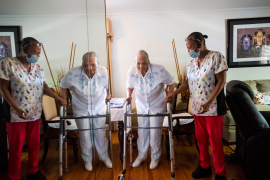This blog post was updated on May 16, 2024.
Decades of evidence shows that primary care is associated with improved health, greater patient satisfaction, and reduced health inequities, and it is strongest when teams of providers coordinate care to address patients’ needs.
Yet the way the United States currently pays for primary care limits this potential. Most primary care providers are paid on a fee-for-service basis — that is, retrospectively for each individual service they provide. This creates incentives for providers to deliver higher-priced services; discourages the provision of nonmedical services like care coordination; and encourages providers to see more patients in a day, spending less time with each.
Experts increasingly agree that to strengthen primary care in the U.S., we should promote “prospective payment” in which providers are given upfront payments to care for each patient for a particular period of time. Prospective payments create a predictable and reliable funding stream that allows providers to invest in hiring staff, technology, and other clinical and operational improvements. Prospective payments also may reduce health care spending by creating financial incentives for providers to lower the total cost of care so they can retain more revenue.
Recognizing that there is a need to shift payment on a national scale, policymakers are considering ways to scale and spread prospective payment for primary care. The Center for Medicare and Medicaid Innovation (CMMI) recently announced two new primary care payment models — Making Care Primary and Primary Care Flex. Both will support coordinated, team-based care through prospective payments. Congress has recently introduced bipartisan legislation, the Pay PCPs Act, which would enable prospective payments for primary care in the Medicare Physician Fee Schedule. As policymakers seek to scale prospective payments, and to ensure they result in better care for patients and providers, they can apply lessons from previous, successfully implemented prospective payment models in primary care.
Lessons from Prospective Payment Innovations
CMMI has tested several large-scale primary care payment models, including Comprehensive Primary Care (CPC), Comprehensive Primary Care Plus (CPC+), and Primary Care First. While they differed slightly, each included a form of non-visit-based prospective payments.
In CMMI-funded evaluations of these models, participating practices emphasized that reliable prospective payments were invaluable for budgeting, hiring staff, and providing services otherwise not paid for. For example, practices used prospective payments to invest in care management programs, particularly for high-risk patients; to coordinate with other health care providers and community-based services; and to hire a broader range of staff, including behavioral health providers, to deliver comprehensive care. A participant in Primary Care First noted, “You’re receiving money on a quarterly basis that helps cash flow of the clinic [for] things that clinics normally do, and that are not reimbursed. Care coordination is not reimbursed, and having those funds upfront is helpful.”
Critically, interviews with practices participating in these models revealed that prospective payments were particularly important during the COVID-19 pandemic. By giving practices stable, consistent revenue, they protected against staff layoffs and allowed practices to maintain critical service delivery, with minimal financial losses. The evaluation of the fourth year of CPC+ found prospective payments “allowed [practices] to maintain key patient care activities — especially care management and care coordination — throughout the pandemic.”
Several states also have developed and tested prospective payment models for primary care, with similarly favorable views among participants. For example, in Maryland’s Primary Care Program, practices reported investing in care management programs, integrating behavioral health into primary care, and addressing health-related social needs of patients.
Improving Prospective Payment for the Future
Despite the positive views, quantitative studies of federal and state prospective payment programs have found mixed and limited impacts on quality, health outcomes, or total cost of care. These results are likely due to flaws in previous model design, which can be solved in the future by addressing:
- Alignment across payers. Research has suggested that at least two-thirds of a practice’s annual payments must be paid prospectively to meaningfully change care delivery, quality, and health. This requires meaningful alignment across public and private payers, as recently announced CMMI models aim to do.
- Amount of prospective payment. Most Primary Care First participants noted that payments were “less than adequate.” Policymakers must carefully ensure payment amounts are sufficient to make desired improvements. Providers who see more complex patients will need thoughtfully designed risk-adjustment approaches.
- Management of financial risk. Prospective payments create risk — if patients require more care than providers are paid for, there may be financial losses, but if patients require less care, there may be savings. To support practices, policymakers can develop on-ramps to financial risk, offer upfront payments and technical assistance to help them transition, and provide a “hybrid” approach that maintains some fee-for-service reimbursement for high-value, underutilized services, like immunizations.
- Long-term investment. Many of the prospective payment approaches that have been tested for primary care have been time limited experiments, making practices hesitant to invest fully in care transformation over the long term. Enabling prospective payment permanently, for example through the Medicare Physician Fee Schedule as Congress has proposed in recent legislation, could be valuable.
To meaningfully improve primary care for patients and providers alike, policymakers can carefully consider these lessons from past innovations when designing and implementing models.






